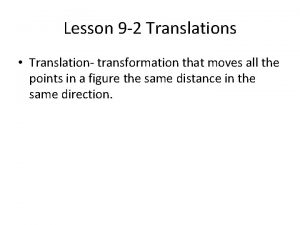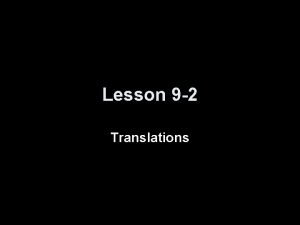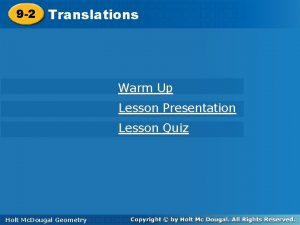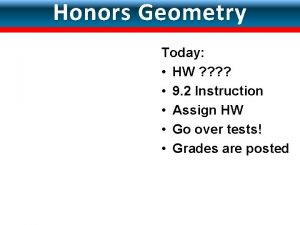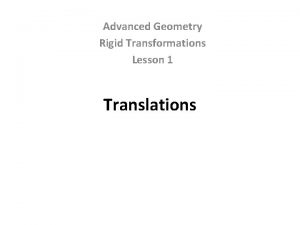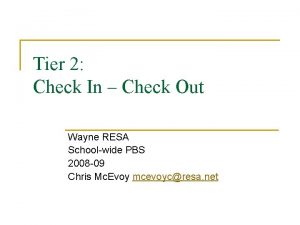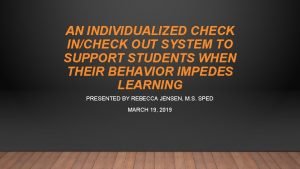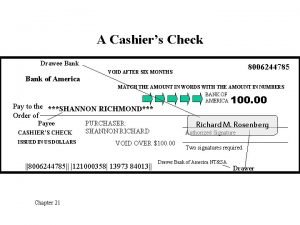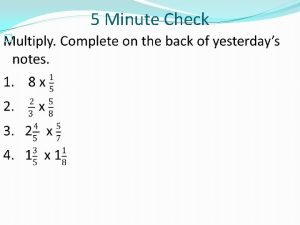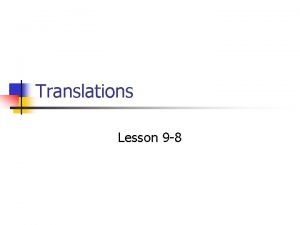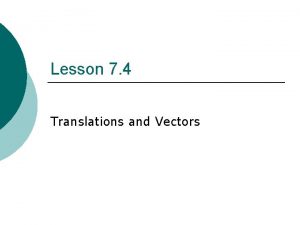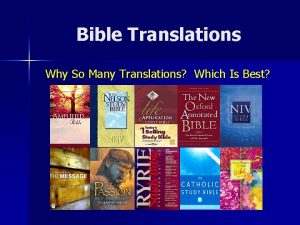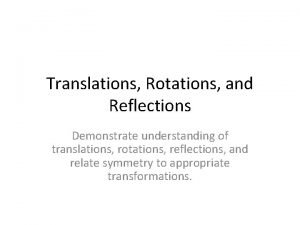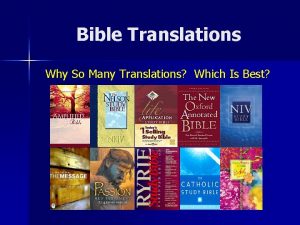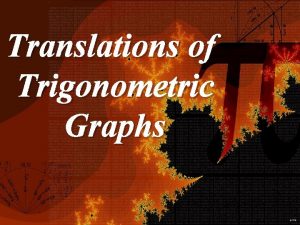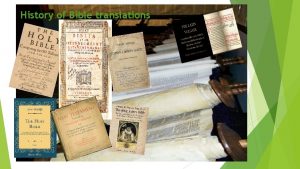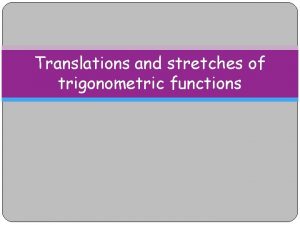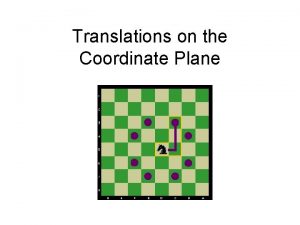Lesson 9 2 Translations 5 Minute Check on














- Slides: 14

Lesson 9 -2 Translations

5 -Minute Check on Lesson 9 -1 Transparency 9 -2 Name the reflected image of each figure in line m 1. BC DC 2. AB ED 3. ∆AGB ∆EGD 4. B D 5. ABCF EDCF 6. Standardized Test Practice: How many lines of symmetry are in an equilateral triangle? A 1 B 2 C 3 D 4 Click the mouse button or press the Space Bar to display the answers.

Objectives • Draw translated images using coordinates • Draw translated images by using repeated reflections

Vocabulary • Translation – transformation that moves all points of a figure the same distance in the same direction • Composition – transformation made up of successive transformations (even number)

Translation – a transformation that moves all points of a figure, the same distance and direction A(6, 8) moved down 11 and left 9 to A’(-3, -3) B(8, 5) moved down 11 and left 9 to B’(-1, -6) C(3, 4) moved down 11 and left 9 to C’(-6, -7) y A C y A(t=4) B A(t=3) x A(t=2) A’ C’ x B’ A(t=1) A(t=0) Composition – transformation made up of successive transformations (animation); also could be successive reflections across parallel lines

COORDINATE GEOMETRY Parallelogram TUVW has vertices T(– 1, 4), U(2, 5), V(4, 3), and W(1, 2). Graph TUVW and its image for the translation (x, y) (x – 4, y – 5). This translation moved every point of the preimage 4 units T(– 1, 4) T' (– 1 – 4, 4 – 5) left and 5 units down. or T' (– 5, – 1) U(2, 5) U' (2 – 4, 5 – 5) or U' (– 2, 0) V(4, 3) V' (4 – 4, 3 – 5) or V' (0, – 2) W(1, 2) W' (1 – 4, 2 – 5) or W' (– 3, – 3) Plot the translated vertices and connect to form parallelogram T'U'V'W'.

COORDINATE GEOMETRY Parallelogram LMNP has vertices L(– 1, 2), M(1, 4), N(3, 2), and P(1, 0). Graph LMNP and its image for the translation (x, y) (x + 3, y – 4). Answer:

ANIMATION The graph shows repeated translations that result in the animation of a raindrop. Find the translation that moves raindrop 2 to raindrop 3 and then the translation that moves raindrop 3 to raindrop 4.

To find the translation from raindrop 2 to raindrop 3, use the coordinates at the top of each raindrop. Use the coordinates (1, 2) and (– 1, – 1) in the formula. Subtract 1 from each side. Subtract 2 from each side.

The translation is (x – 2, y – 3) from raindrop 2 to raindrop 3. Use the coordinates (– 1, – 1) and (– 1, – 4) to find the translation from raindrop 3 to raindrop 4. (x, y) (– 1, – 1) (– 1, – 4) Add 1 to each side. The translation is Answer: from raindrop 3 to raindrop 4.

ANIMATION The graph shows repeated translations that result in the animation of a lightning bolt. Find the translation that moves lightning bolt 3 to lightning bolt 4 and then the translation that moves lightning bolt 2 to lightning bolt 1. Answer: (x – 3, y – 1); (x + 2, y + 2)

In the figure, lines p and q are parallel. Determine whether the pink figure is a translation image of the blue preimage, quadrilateral EFGH. Reflect quadrilateral EFGH in line p. The result is the green image, quadrilateral E'F'G'H'. This is not a reflection of quadrilateral EFGH in line p, so quadrilateral E'F'G'H' is not a translation of quadrilateral EFGH. Answer: Quadrilateral E''F''G''H'' is not a translation image of quadrilateral EFGH.

In the figure, lines n and m are parallel. Determine whether A''B''C'' is a translation image of the preimage, ABC. Answer: Yes, A''B''C'' is the translation image of ABC.

Summary & Homework • Summary: – A translation moves all points of a figure the same distance in the same direction – A translation can be represented as a composition of reflections • Homework: – pg 472 -474; 8 -10, 12 -13, 17 -19, 27
 1 hour 40 minutes in minutes
1 hour 40 minutes in minutes Lesson 9-2 transformations
Lesson 9-2 transformations 9-2 translations answers
9-2 translations answers Lesson 9-2 translations
Lesson 9-2 translations Lesson 9-2 transformations
Lesson 9-2 transformations Lesson 1 translations
Lesson 1 translations Behavior check in check out sheet
Behavior check in check out sheet Check in check out forms
Check in check out forms Check in check out
Check in check out Check in check out system
Check in check out system Cashier check
Cashier check Advantages and disadvantages of scan line fill algorithm
Advantages and disadvantages of scan line fill algorithm Check in check out pbis
Check in check out pbis Check-in check-out intervention
Check-in check-out intervention The fan blade is speeding up. what are the signs of
The fan blade is speeding up. what are the signs of

